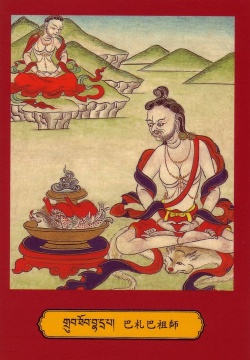Bhadrapa
Mahasiddha Bhadrapa… Bhadrapa / Bhadrapāda (bzang po): “The Auspicious One”/”The Snob”
Bhadrapa was a very conservative and wealthy Brahmin. He never consume pork or strong drinks, no menstruating women were allowed near him, and will never risk his ritual purity by manual labour or coming into contact with filth or excrement. However, despite his wealth and position in society, he constantly worries about how he appeared in the eyes of others and was obsessed with maintaining his image untarnished.
One day, when he was alone in the house, a yogin appeared on his doorstep begging for food. Forced to speak to the yogin himself, he hurried to the doorstep to rid the yogin from him house before anyone saw him, because he perceived the yogin unclean due to the holy man’s humble outlook.
The yogin then replied, “This is not unclean. The visciousness in speech, mind, and action – that is unclean.” The yogin sang:
Neither priest nor king is the highest of beings,
Only the Bodhisattvas
No amount of scrubbing
Can cleanse body, speech, and mind
Only the precepts of the lineal guru
Give matchless purity
No rich man’s feast of milk, cheese, and curd
Only desirelessness sets the best table.
The Brahmin gained confidence in the yogin and begged him for instructions. The yogin said he would be glad to teach if the Brahmin gave him food. The Brahmin agreed, but he was afraid he would be seen by his neighbors. After much debate, it was agreed that the Brahmin was to bring pork and liquor (which he acquired by disguising as a low-caste) to the yogin’s house in the cremation ground at night.
When night fall, the guru welcomed him, prepared the supper and insisted the Brahmin share it with him. Afterward, the guru initiated the Brahmin into the mandala of thanksgiving with a transfer of grace. Then began a series of practices designed to break the Brahmin’s pride of caste, which was done by the Brahmin, ordered to clean, and fix the yogin’s hut. When all was done to his master’s satisfaction, the guru told him that all these acts symbolized the goal of practice. The Brahmin suddenly understood that vision, meditation, and action were all one and the same. Then and there, he forsook his caste and became a yogin.
After 6 years of meditation, he achieved mahamudra-siddhi and became renowned. For the remainder of his life he worked selflessly for others. And when the time came, the assumed into the Paradise of the Dakinis with 500 disciples.
